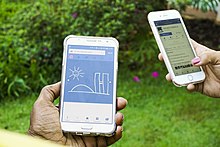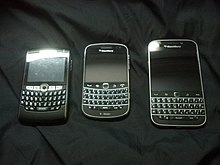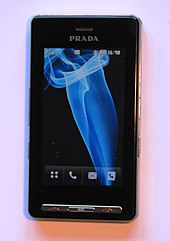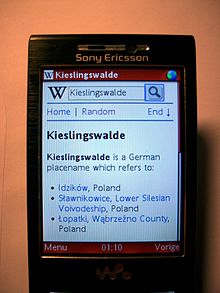SMART PHONE
 |
| Two smartphones : a Samsaung Galaxy J5 ( Left ) and an iPhone 6S ( right ) |
A phone is a portable device that combines mobile telephone and computing functions into one unit. They are distinguished from characteristic phones via their stronger hardware competencies and tremendous cell operating systems, which facilitate wider software, net (together with web browsing over cell broadband), and multimedia capability (along with track, video, cameras, and gaming), alongside center telephone features which includes voice calls and text messaging. Smartphones normally include a number of metallic–oxide–semiconductor (MOS) integrated circuit (IC) chips, include various sensors that may be leveraged through pre-protected and third-party software (inclusive of a magnetometer, proximity sensors, barometer, gyroscope, accelerometer and more), and help wi-fi communications protocols (which includes Bluetooth, Wi-Fi, or satellite navigation).
Early smartphones were marketed ordinarily in the direction of the company marketplace, attempting to bridge the functionality of standalone personal digital assistant (PDA) gadgets with assist for cell telephony, but were restrained via their cumbersome form, brief battery lifestyles, slow analog mobile networks, and the immaturity of wireless information services. These problems had been sooner or later resolved with the exponential scaling and miniaturization of MOS transistors all the way down to sub-micron stages (Moore's law), the stepped forward lithium-ion battery, quicker digital mobile records networks (Edholm's law), and greater mature software platforms that allowed cell tool ecosystems to broaden independently of statistics providers.
In the 2000s, NTT DoCoMo's i-mode platform, BlackBerry, Nokia's Symbian platform, and Windows Mobile started out to benefit marketplace traction, with fashions regularly featuring QWERTY keyboards or resistive touchscreen input, and emphasizing get right of entry to to push mail and wi-fi net. Following the growing reputation of the iPhone within the late 2000s, the general public of smartphones have featured skinny, slate-like form elements, with big, capacitive monitors with guide for multi-touch gestures rather than bodily keyboards, and offer the capacity for users to download or buy additional applications from a centralized store, and use cloud garage and synchronization, virtual assistants, in addition to cellular charge offerings. Smartphones have in large part changed PDAs, handheld/palm-sized PCs and portable media plpayer (PMP).
Improved hardware and faster wireless verbal exchange (because of requirements inclusive of LTE) have bolstered the growth of the cellphone enterprise. In the 1/3 area of 2012, a billion smartphones had been in use global. Global telephone sales passed the income figures for characteristic telephones in early 2013.
History
The improvement of the phone turned into enabled by way of numerous key technological advances. The exponential scaling and miniaturization of MOSFETs (MOS transistors) right down to sub-micron level all through the Nineteen Nineties–2000s (as anticipated by using Moore's law) made it viable to build portable clever gadgets which includes smartphones, in addition to allowing the transition from analog to faster digital wireless mobile networks (leading to Edholm's law). Other vital permitting factors include the lithium-ion battery, an indispensable strength supply allowing lengthy battery life, invented in the Eighties and commercialized in 1991, and the development of greater mature software program structures that allowed mobile tool ecosystems to develop independently of data providers
Forerunner
 |
| IBM Simon and charging base ( 1994 ) |
In the early Nineties, IBM engineer Frank Canova realised that chip-and-wi-fi generation was becoming small enough to apply in handheld gadgets. The first commercially to be had tool that would be properly referred to as a "telephone" started out as a prototype known as "Angler" advanced by way of Canova in 1992 whilst at IBM and confirmed in November of that 12 months on the COMDEX computer enterprise alternate display. A delicate version turned into advertised to consumers in 1994 by means of BellSouth underneath the call Simon Personal Communicator. In addition to setting and receiving mobile calls, the touchscreen-ready Simon could send and acquire faxes and emails. It covered an deal with e book, calendar, appointment scheduler, calculator, global time clock, and notepad, in addition to other visionary cellular programs including maps, stock reviews and news.
The IBM Simon become manufactured through Mitsubishi Electric, which integrated functions from its personal wireless private digital assistant (PDA) and cellular radio technologies. It featured a liquid-crystal display (LCD) and PC Card aid. The Simon changed into commercially unsuccessful, specially because of its bulky shape thing and confined battery life, the use of NiCad batteries in place of the nickel–metal hydride batteries typically used in cellular phones within the 1990s, or lithium-ion batteries utilized in current smartphones.
The time period "smart phone" was no longer coined until a yr after the introduction of the Simon, appearing in print as early as 1995, describing AT&T's PhoneWriter Communicator.The term "telephone" became first used by Ericsson in 1997 to describe a brand new tool idea, the GS88.
PDA/phone hybrids
Beginning inside the mid-overdue 1990s, many those who had cell phones carried a separate dedicated PDA device, going for walks early variations of working systems consisting of Palm OS, Newton OS, Symbian or Windows CE/Pocket PC. These working systems could later evolve into early mobile operating systems. Most of the "smartphones" in this era have been hybrid gadgets that blended these current acquainted PDA OSes with fundamental telephone hardware. The results were gadgets that have been bulkier than either devoted cell telephones or PDAs, but allowed a restricted quantity of cellular Internet get admission to. PDA and cellular phone manufacturers competed in reducing the scale of devices. The bulk of those smartphones combined with their high fee and high-priced facts plans, plus other drawbacks which includes enlargement barriers and decreased battery life as compared to separate standalone devices, normally restricted their popularity to "early adopters" and commercial enterprise users who needed portable connectivity.
In March 1996, Hewlett-Packard released the OmniGo 700LX, a changed HP 200LX palmtop PC with a Nokia 2110 mobile smartphone piggybacked onto it and ROM-based totally software program to help it. It had a 640×2 hundred decision CGA well matched 4-coloration grey-scale LCD screen and might be used to region and obtain calls, and to create and get hold of text messages, emails and faxes. It was additionally a hundred% DOS 5.0 well suited, permitting it to run hundreds of current software program titles, such as early versions of Windows.
 |
| The Nokia 9000 Communicator ( right ) and the updated 9110 model ( left ) |
In August 1996, Nokia launched the Nokia 9000 Communicator a virtual mobile PDA based totally at the Nokia 2110 with an included machine based on the PEN/GEOS 3.0 operating device from Geoworks. The components were connected by way of a hinge in what have become known as a clamshell design, with the display above and a physical Qualcomm QWERTY keyboard beneath. The PDA supplied e mail; calendar, deal with e book, calculator and notebook programs; text-primarily based Web browsing; and could ship and get hold of faxes. When closed, the tool may be used as a digital cell phone.
In June 1999 Qualcomm released the "pdQ Smartphone", a CDMA digital PCS smartphone with an included Palm PDA and Internet connectivity.
Subsequent landmark devices protected:
* The Ericsson R380 (December 2000)[26] by Ericsson Mobile Communications , the primary cellphone going for walks the working device later named Symbian (it ran EPOC Release five, which become renamed Symbian OS at Release 6). It had PDA functionality and constrained Web surfing on a resistive touchscreen making use of a stylus. While it was marketed as a "cellphone", users couldn't set up their own software program on the tool.
* Advertised as a "phone", customers couldn't set up their personal software program at the device.
The Kyocera 6035 (February 2001), a dual-nature device with a separate Palm OS PDA working gadget and CDMA cell cellphone firmware. It supported restricted Web surfing with the PDA software program treating the phone hardware as an connected modem.
* The Nokia 9210 Communicator (June 2001), the first smartphone walking Symbian (Release 6) with Nokia's Series 80 platform (v1.Zero). This turned into the primary Symbian telephone platform permitting the set up of additional applications. Like the Nokia 9000 Communicator it is a huge clamshell device with a complete bodily QWERTY keyboard inner.
* Handspring's Treo one hundred eighty (2002), the first telephone that completely integrated the Palm OS on a GSM cellular telephone having telephony, SMS messaging and Internet get right of entry to built into the OS. The a hundred and eighty model had a thumb-kind keyboard and the 180g version had a Graffiti handwriting popularity location, as an alternative.
Japanese cell phones
In 1999, Japanese wi-fi provider NTT DoCoMo released i-mode, a brand new cellular net platform which supplied records transmission accelerates to nine.6 kilobits in step with 2nd, and get entry to web offerings to be had through the platform including online buying. NTT DoCoMo's i-mode used cHTML, a language which limited some elements of traditional HTML in favor of growing facts velocity for the devices. Limited capability, small monitors and constrained bandwidth allowed for telephones to use the slower data speeds to be had. The upward thrust of i-mode helped NTT DoCoMo collect an predicted 40 million subscribers via the quit of 2001, and ranked first in market capitalization in Japan and 2nd globally. Japanese cell phones increasingly more diverged from global standards and traits to offer different sorts of superior offerings and cellphone-like capability that have been specially tailored to the Japanese marketplace, which include mobile bills and purchasing, near-area conversation (NFC) allowing cell pockets capability to replace clever playing cards for transit fares, loyalty playing cards, identity cards, occasion tickets, coupons, money transfer, and so forth., downloadable content material like musical ringtones, games, and comics, and 1seg cell tv. Phones constructed by way of Japanese manufacturers used custom firmware, but, and failed to yet feature standardized cell running structures designed to cater to 1/3-birthday party application improvement, so their software and ecosystems had been similar to very advanced characteristic telephones. As with other characteristic telephones, additional software and offerings required partnerships and deals with carriers.
The degree of integration between phones and providers, precise smartphone capabilities, non-standardized platforms, and tailoring to Japanese culture made it tough for Japanese producers to export their telephones, specifically while call for became so excessive in Japan that the groups failed to feel the need to look some other place for added profits.
The upward thrust of 3G generation in other markets and non-Japanese telephones with powerful standardized mobile operating systems, app stores, and superior wi-fi community abilties allowed non-Japanese telephone manufacturers to subsequently wreck in to the Japanese market, gradually adopting Japanese smartphone features like emojis, mobile payments, NFC, and so on. And spreading them to the relaxation of the world.
Early smartphones
 |
| Several Blackberry smartsphone , which were highly popular in the midlate 2000s |
Phones that made powerful use of any large records connectivity were nevertheless uncommon out of doors Japan till the creation of the Danger Hiptop in 2002, which noticed moderate fulfillment amongst U.S. Consumers as the T-Mobile Sidekick. Later, within the mid-2000s, commercial enterprise users in the U.S. Began to undertake gadgets primarily based on Microsoft's Windows Mobile, and then BlackBerry smartphones from Research In Motion. American customers popularized the term "CrackBerry" in 2006 due to the BlackBerry's addictive nature. In the U.S., the high value of facts plans and relative rarity of devices with Wi-Fi abilities that would avoid mobile information community utilization saved adoption of smartphones especially to enterprise specialists and "early adopters."
Outside the U.S. And Japan, Nokia was seeing fulfillment with its smartphones primarily based on Symbian, in the beginning evolved by way of Psion for his or her private organisers, and it changed into the most popular phone OS in Europe at some point of the middle to late 2000s. Initially, Nokia's Symbian smartphones had been centered on business with the Eseries, just like Windows Mobile and BlackBerry gadgets on the time. From 2006 onwards, Nokia began generating client-focused smartphones, popularized with the aid of the entertainment-targeted Nseries. Until 2010, Symbian became the sector's maximum broadly used phone running system.
The touchscreen personal digital assistant (PDA)-derived nature of adapted working structures like Palm OS, the "Pocket PC" variations of what became later Windows Mobile, and the UIQ interface that become at the start designed for pen-based PDAs on Symbian OS devices led to some early smartphones having stylus-primarily based interfaces. These allowed for digital keyboards and/or handwriting input, as a consequence also permitting smooth access of Asian characters.
By the mid-2000s, the majority of smartphones had a physical QWERTY keyboard. Most used a "keyboard bar" form element, just like the BlackBerry line, Windows Mobile smartphones, Palm Treos, and some of the Nokia Eseries. A few hid their full physical QWERTY keyboard in a sliding form issue, like the Danger Hiptop line. Some even had simplest a numeric keypad the usage of T9 text enter, just like the Nokia Nseries and other fashions within the Nokia Eseries. Resistive touchscreens with stylus-primarily based interfaces should still be discovered on some smartphones, like the Palm Treos, which had dropped their handwriting enter after some early fashions that have been to be had in variations with Graffiti instead of a keyboard.
From factor and operating system shifts
 |
| The LD Pradaa with a large capacitive touchscreen introduced in 2006 |
The past due 2000s and early 2010s noticed a shift in telephone interfaces far factor devices with physical keyboards and keypads to ones with huge finger-operated capacitive touchscreens. The first smartphone of any kind with a huge capacitive touchscreen become the LG Prada, announced by LG in December 2006. This became a stylish feature smartphone created in collaboration with Italian luxurious designer Prada with a three" 240x400 pixel screen, a 2-Megapixel virtual digital camera with 144p video recording capacity, an LED flash, and a miniature replicate for self pictures.
In January 2007, Apple Computer delivered the iPhone. It had a 3.5" capacitive touchscreen with twice the not unusual decision of maximum telephone displays at the time, and delivered multi-touch to telephones, which allowed gestures such as "pinching" to zoom in or out on pictures, maps, and internet pages. The iPhone turned into incredible as being the first device of its kind focused at the mass marketplace to desert the use of a stylus, keyboard, or keypad common of present day smartphones, as a substitute the use of a massive touchscreen for direct finger enter as its most important way of interplay.
 |
| The original Apple iPhone ; following its introduction the common smartphone from factor shifted to large touch screen software interfaces without physical keypads |
The iPhone's operating machine become additionally a shift faraway from preceding ones that had been tailored from PDAs and feature telephones, to 1 powerful sufficient to avoid the usage of a confined, stripped down net browser requiring pages particularly formatted using technology together with WML, cHTML, or XHTML that preceding phones supported and as a substitute run a version of Apple's Safari browser that might without problems render full websites now not mainly designed for telephones.
Later Apple shipped a software replace that gave the iPhone a built-in on-device App Store permitting direct wireless downloads of third-birthday party software program. This type of centralized App Store and loose developer tools speedy became the new main paradigm for all phone systems for software improvement, distribution, discovery, set up, and charge, in region of high priced developer tools that required official approval to use and a dependence on 0.33-celebration assets supplying packages for a couple of platforms.
The blessings of a design with software program powerful sufficient to aid advanced packages and a massive capacitive touchscreen affected the improvement of any other phone OS platform, Android, with a more BlackBerry-like prototype tool scrapped in prefer of a touchscreen tool with a slide-out bodily keyboard, as Google's engineers idea at the time that a touchscreen could not absolutely update a physical keyboard and buttons. Android is based totally round a modified Linux kernel, once more providing extra electricity than mobile working systems tailored from PDAs and feature telephones. The first Android device, the horizontal-sliding HTC Dream, became launched in September 2008.
In 2012, Asus started out experimenting with a convertible docking gadget named PadFone, wherein the standalone handset can while important be inserted into a pill-sized display unit with included supportive battery and used as such.
In 2013 and 2014, Samsung experimented with the hybrid mixture of compact camera and cellphone, releasing the Galaxy S4 Zoom and K Zoom, every geared up with integrated 10× optical zoom lens and guide parameter settings (along with guide exposure and focus) years earlier than those were widely adapted amongst smartphones. The S4 Zoom moreover has a rotary knob ring around the lens and a tripod mount.
WRITTEN BY : ADRISH WAHEED
Labels: SMART PHONE
















